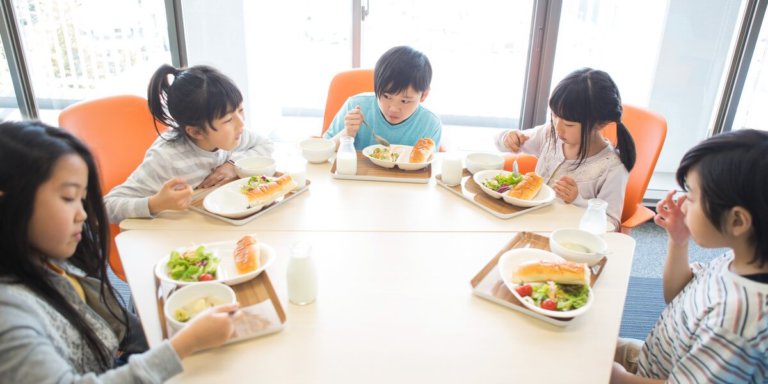
A flagship report by UNICEF, The State of the World’s Children, recently shed some light on the nutritional habits of children around the world.
According to the report, “Despite progress in the past two decades, one third of children under age 5 are malnourished – stunted, wasted or overweight – while two thirds are at risk of malnutrition and hidden hunger because of the poor quality of their diets.”
The data also showed that a significant number of children in Southeast Asian countries such as the Philippines, Indonesia and Malaysia eat too many packets of instant noodles. However, Japan emerged as the healthiest nation for children.
According to AFP, “A landmark report by the UN’s children agency UNICEF released Tuesday (Oct 15) shows Japan topping the charts for childhood health indicators, with low rates of infant mortality and few underweight children.
“But it also manages the lowest incidence of childhood obesity among the 41 developed countries in the Organisation for Economic Cooperation and Development and European Union.”
The country is well known for its healthy diet comprised of a good balance of fresh and seasonal greens and seafood. Their nutritional habits extend to school lunches in government schools, as well.
Mitsuhiko Hara, a paediatrician and professor at Tokyo Kasei Gakuin University, told AFP, “School lunches with menus that are created by nutritionists are provided to all primary schools and the majority of junior high schools throughout Japan.”
Since children eat at least five meals per week at school (some even eat breakfast at school, too), schools hold a responsibility to ensure meals are not contributing to unhealthy diets lacking in nutritional value.
Unfortunately, while some countries such as the US are taking steps to offer better school lunches, and international or private schools offer more well-balanced choices, many schools – particularly those in low-income neighbourhoods – still aren’t offering nutritional meals in school.
Here’s what other countries and schools can take away from Japan’s healthy school lunches:
Kids are educated on what they are eating
School lunch and health education in America vs. Japan 👀 HUGE difference! https://t.co/jMdrb3W8u4 pic.twitter.com/8O1lD8Oo28
— KnowYourRightsCamp (@yourrightscamp) December 28, 2016
The key to a lifelong habit of healthy eating is to build an awareness of nutritional habits from an early age.
Unlike schools in other countries where lunch is typically served in the cafeteria, school lunches in Japan are served in the classroom.
This is because children’s nutrition is embedded in the educational structure of the school so that students know what they are eating and why.
Hara said, “There’s also a daily broadcast at school to explain the nutritional elements contained in the school lunch of the day, and this is a good way to educate kids.”
In Japanese primary schools, students use magnets with pictures of food and place them into different categories on a whiteboard, so they learn how to tell their proteins from their carbs.
Education ministry official Mayumi Ueda told AFP, “School lunch is positioned as part of education under the law. It’s not just about eating food, but children learn to serve, and clean up on their own.”
She added that the Japanese government studies nutrition and eating habits in Japan annually, and uses the results to shape what goes into the school meals.
School lunches are mandatory
Kyushoku: The Familiar School Lunch for Japanese Kids https://t.co/gqsvkIb7ru#GJ #Japan pic.twitter.com/TlGF9gvdtU
— Goin’ Japanesque! (@Goin_Japanesque) February 5, 2017
In many countries, students have the option to bring their own school lunches or buy from the cafeteria.
However, in Japan’s public schools, school lunches provided by the school are mandatory. There are no concessions for those who have special dietary requirement or are vegetarian. This might be an issue in some countries, but students from these groups are rare in Japan.
Since the meals are mandatory, students don’t have a choice but to consume the healthy and nutritionally-planned meals provided.
While those from lower-income groups in countries outside of Japan may need to pack meals from home for their kids to keep household costs lower or accommodate dietary restrictions, Japan’s school lunches are heavily subsidised by the government.
This means that even those from lower-income families can afford to eat healthy and parents don’t need to worry about packing school lunches.
According to AFP, a number of children from lower-income groups in Japan still suffer from childhood obesity.
Hara said, “Children in poverty are more likely to be overweight because families try to cut costs. As a result, they eat less protein but consume more carbs and sugar, which leads to obesity.”
Therefore, school lunches are all the more important to children in these situations. “A lot of nutrition is supplemented by school lunches…so it also serves as a meal that saves children in poverty.”
Ueda said, “School lunch is designed to provide nutrition that tends to be lacking in meals at home. I think it contributes to the nutritional balance necessary for children.”
Of course, in countries where diets vary, special accommodations should be provided if meals are made mandatory.
This can be easily worked out by letting the school lunch provider know early in advance, or by the school offering different options for those with allergies or special diets.
Everything is fresh and well-balanced
Japan’s school lunch program is a model for the rest of the world – https://t.co/v42443Y02C pic.twitter.com/0U4k0NvlS5
— Ken Rutkowski (@kenradio) March 27, 2017
AFP reported, “One sample meal served to children in Japan’s Gunma gives a flavour: rice with grilled fish and a spinach and sprout dish, served with miso soup with pork, alongside milk and dry prunes.”
“Each meal is designed to have around 600-700 calories balanced between carbohydrates, meat or fish and vegetables.”
School lunches in Japan are made fresh, using whole foods instead of frozen or processed food, to preserve the original nutritional value of the food.
The ingredients are also fresh as food is selected based on the season, so schools don’t have to rely on frozen or canned food.
Hara said, “Because many Japanese are health-conscious, they try to eat a variety of food, which is good.
“And we’re taught to eat seasonal food, which also contributes to good health. Japan is one of the rare countries that pay so much attention to food that is associated with specific seasons.”
Liked this? Then you’ll love…
3 Japanese concepts that reshape your study style
A new Japanese-English boarding school is opening in the Chūgoku Mountains








